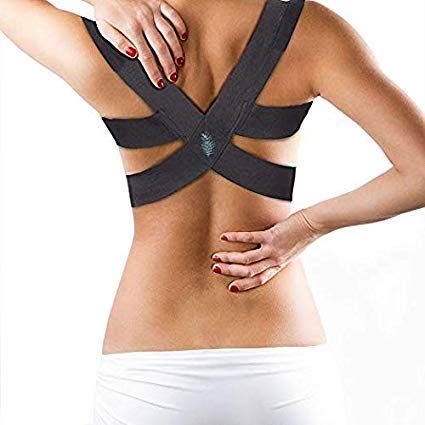Okay, admit it: You sit at a desk most of the day or hunched over your phone DMing memes to your friends. By the time you’re home for the evening, you have some serious aches in your back, shoulders, and neck. Your posture could probably use some work, let’s be real.

There is such a thing as *bad* posture, and slouching or bending your spine in strange ways all the time can hurt you physically and psychologically, says Dave Smith, a postural alignment specialist and consultant for the San Francisco 49ers, many NCAA players, and the U.S. Women’s Tennis Association. Bad posture can make your muscles imbalanced, weak, or too tight which can lead to pain, degenerative joints and discs, injuries, and even osteoarthritis, he says.
Sooo how do you train yourself to sit and stand with proper posture? Your first instinct may be to turn try one of those posture-correcting devices you’ve seen advertised all over social media. But do posture correctors really work? There are pros and cons, experts say.
There are different types of posture correctors.
Some are physical correctors, like braces, that manually hold your shoulders and back in alignment. There are also apps and gadgets on the market that help send you little reminders to stop slouching. (With these, you still have to be the one to fix your own posture.)
Posture support tools may be helpful for some people, experts hear anecdotally. But there’s no scientific data that posture support tools make a significant difference, says says Neel Anand, MD, professor of orthopaedic surgery and director of spine trauma at Cedars-Sinai Spine Center in Los Angeles.

But they still might be worthwhile. While they’re not a magic wand for taking you from Neanderthal to ballerina, posture correctors can help you find your best posture and make you more aware of how you’re sitting and standing day to daywhen used *in tandem* with a strengthening program and for a limited amount of time.
“The real benefit of these devices is that they bring your awareness to your posture and that alone can reduce pain and increase confidence,” Dr. Anand says.
But if you use these gadgets *too* much—particularly physical braces—then your muscles may become dependent on them and actually weaken, worsening your posture in the long run, says Smith, who is also a therapist with the posture therapy clinic Egoscue.
“This is why it’s so important to use any posture device in conjunction with a posture-strengthening exercise routine,” he says, adding that a good posture program should target the muscles in your core, hips, glutes, lower back, and upper back. (You can start with these exercises designed to improve your posture.)
Here, we break down the features of the most popular devices on the market, and what experts really think of each one.
1. Cross-back elastic brace

These posture correctors are basic and easy to use—not to mention, easy to find. You may be able to get one from your physical therapist’s office, or you can search on Amazon to find options (like the one to the right!).
Just slip it on over your shoulders, and it wraps around your upper back. It almost feels like you’re wearing a bra backwards. This is a good thing, as this device helps to counteract the effect of the weight of your breasts pulling your chest and front side forward, Smith says.
Out of all of the physical posture support devices, this one provides the lightest support but is also the most comfortable and the least visible under clothing.
2. Electronic Posture Reminder

If all you need is a gentle reminder to alert you when you’re slouching, you can try one of the wearable devices, Smith says.
These attach either via a clip to the front of your bra or with adhesive to the skin on your upper back and vibrate when your posture starts to slip. Some also come with an app for your phone so you can track your stats over time.
Keep in mind that these are more expensive than standard braces and require charging or batteries but they’re invisible under clothing. If you like the idea of having a posture reminder during the day but don’t want to spend the money, you can set up your watch to alert you at specified intervals.
Once an hour, set a smartphone alert that instructs you to check your posture as well as take a break to stand, walk, and stretch. “Our sedentary lifestyle is one of the main reasons for back pain and the best thing you can do is get more motion,” says Smith.
3. Molded upper back brace

These braces are worn similarly to the elastic brace but include a stiff plastic or metal piece that sits vertically between your shoulder blades.
A molded brace tends to offer more adjustable, firmer support and gives a solid reminder to pull your shoulder blades back to counteract your tendency to hunch over your computer or phone, Smith says.
The issue? The bulkier style of this brace means it can show through clothing. But given that you don’t want to wear physical braces 24/7 anyway (because your muscles may get too used to them and grow weaker), you could wear this around the house for shorter intervals and leave it off when you’re wearing something more form-fitting in public.
4. Longline back brace

If your posture is seriously out of alignment or you have existing low-back pain, you may prefer a longline brace that provides support from the base of your neck to the top of your hip, Dr. Anand says.
You slip this one over your shoulders and then wrap a wide piece of elastic around your low back and stomach. One thing to note: It provides very firm support throughout your back, but it can be quite visible through clothing, similar to the option above.
5. Magnetic Back Brace

Many popular brace styles claim that strategically positioned magnets within them have pain-reducing powers. While that sounds…pretty unlikely…magnet-containing braces are not harmful if you like how they feel (some reviewers say the weight of the magnets feel relaxing or soothing).
One Amazon reviewer said, “I’ve only had this for a few days but can feel a difference already.” Another wrote, “This guy became my best friend recently. After nine hours in the office sitting in front of the computer, it’s such a relief for my back!”
And if the brace helps you remember to correct your posture then they’re totally fine, Smith says. “There is no research that adding magnets to a back brace helps in any way but I’ve heard anecdotal reports from patients who’ve said they like it,” Smith says.
Source: Read Full Article
